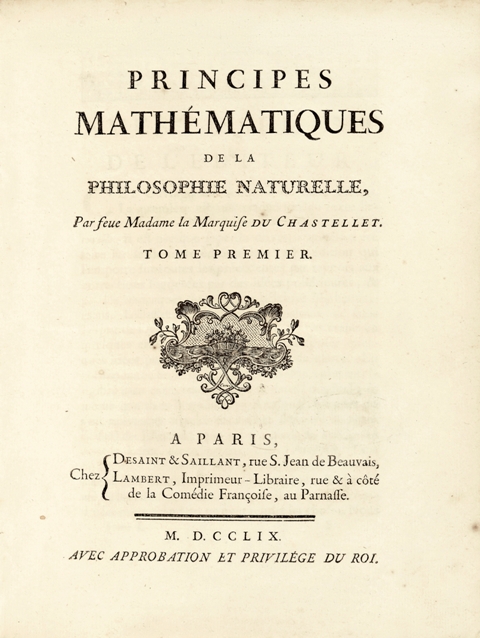Émilie du Châtelet
This page has been claimed by Taylor Poulos (tpoulos3)
Life
Émilie du Châtelet was born in Paris on December 17th, 1706. As an academically gifted child, she was able to study Latin, Italian and English, which was impressive during this time for a young girl in 18th century France. She was encouraged at an early age to pursue mathematics by a family friend, M. de Mezieres. She spent a significant amount of time working alongside Voltaire at Cirey and working with famous tutors such as Samuel Koenig. In 1749 and died following the birth of her fourth child.
Academic Works
In 1740, she completed Institutions de Physique as well as a French translation of Newton's Principia. Through this work, she contributed to the shift in France away from an acceptance of Cartesian physics and toward the embrace of Newtonian physics. In her own work, Du Châtelet sought a metaphysical basis for the Newtonian physics she embraced following the rejecting of Cartesianism. She died shortly after she completed this work, which remained unpublished until 1759. It is still the leading French translation of Newton's book.
In 1740 she published her Institutions de physique (The Foundations of Physics) ostensibly a textbook in physics for her son, but in reality a highly original work in natural philosophy (a second edition was published in 1742 under the slightly altered title Institutions physique). It was in this text—her magnum opus—that she supplied the metaphysical basis for the Newtonian physics she had long accepted. This metaphysics was Leibnizian and Wolffian in flavor. Her inclusion of a defense of force vive (she thus sided with Leibniz on this question) led to her subsequent dispute on the issue with Jean-Jacques Dortous de Mairan.
Influences and Companions
Émilie was familiar with, or was tutored by all of the following: Pierre Louis de Maupertuis, Alexis-Claude Clairaut, Samuel Koenig, and several members of the Bernoulli family. With her advanced capabilities in both mathematics and physics, she was able to write capably about Newton's physics.
Influence on Voltaire
Voltaire has acknowledged Émilie du Châtelet's significant contribution to his book, Eléments de la philosophie de Newton, written in 1738.
Lost Works
For many years, it was believed that there was one surviving chapter from an otherwise lost work written by Du Châtelet—her “Essai sur l'optique” (ca. 1736). As a fascinating side note on how dynamic Du Châtelet studies are, in recent years fully three complete copies of her Essai have been found, one in Bernoulli's papers in Basel (Nagel 2012) and two that have been acquired recently by the Musée des lettres et manuscrits in Paris.
Study of Fire
In 1737 Du Châtelet entered a competition to explain the nature of fire, conducting her experiments in secret while Voltaire also conducted experiments for his entry to the competition. Both Du Châtelet's and Voltaire's entries aimed to disprove the theory that fire is a material substance, and both were published along with the three winners (including the essay essay by Leonhard Euler, which took the top prize). Du Châtelet returned to this project a number of times thereafter, making significant revisions to the original text as her ideas on the nature of fire matured and changed.
Non-technical Writings
While Du Châtelet's primary interest was in natural philosophy, she also had interests in ethics (translating of portions of Mandeville's Fable of the Bees), theology and the Bible (writing a book titled Examens de la Bible), and the source of human happiness (writing a semi-autobiographical book, Discours sur le bonheur). Her non-scientific work occasionally touched on the subject of women's social roles and their education.
Connectedness
- How is this topic connected to something that you are interested in?
- How is it connected to your major?
- Is there an interesting industrial application?
History
Put this idea in historical context. Give the reader the Who, What, When, Where, and Why.
See also
Are there related topics or categories in this wiki resource for the curious reader to explore? How does this topic fit into that context?
Further reading
Books, Articles or other print media on this topic
External links
Internet resources on this topic
References
https://www.agnesscott.edu/lriddle/women/chatelet.htm http://plato.stanford.edu/entries/emilie-du-chatelet/

